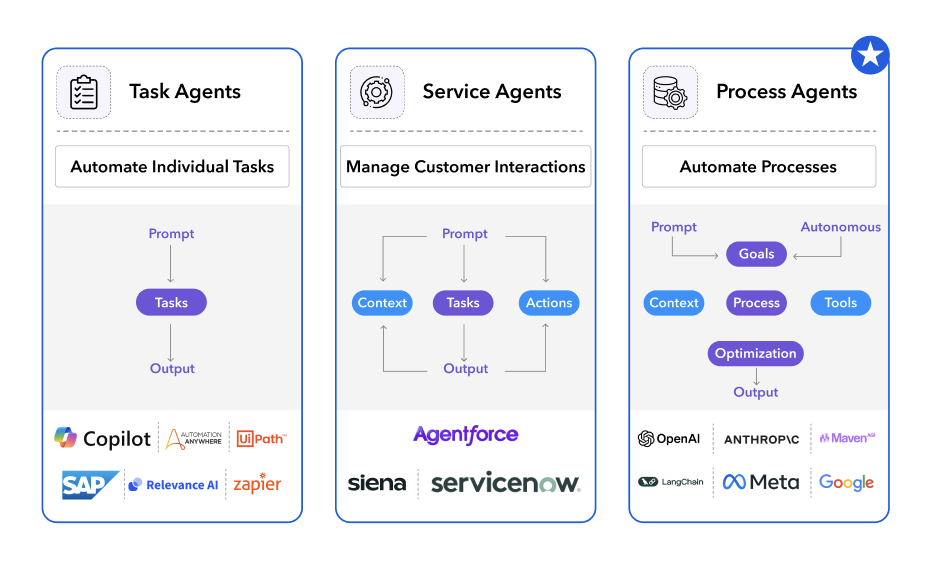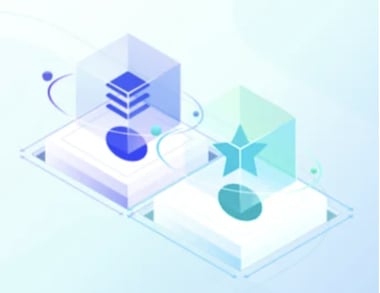Agentic Automation is Here. But Are You Targeting the Right Use Cases?
Over the past few weeks, I've been in deep conversations with leaders across industries, exploring how they're approaching Agentic AI in enterprise operations. From financial services to healthcare, from insurance to IT service management, the buzz around Agentic AI is unmistakable. The potential is massive-but execution is everything. When you dig deeper, actual deployment strategies reveal a troubling pattern.
Many organizations are experimenting with AI, but few are unlocking its full transformative potential. Per McKinsey, 78% of organizations reported using AI in at least one business function, up from 72% in early 2024 and 55% a year earlier. Similarly, Forrester predicts that GenAI will manage less than 1% of core business processes in 2025, highlighting that while AI agents offer potential, their current impact is limited.
The gap between AI aspirations and real-world impact remains wide, and the key to bridging it lies in targeting the right use cases.
Most responses fall into three predictable categories:
- Task Agents - These are the usual suspects: travel planners, file managers, report generators. They're great for individual productivity, automating repetitive low-level tasks, and streamlining day-to-day operations. But here's the reality check: they barely dent enterprise operational excellence. Automating small tasks doesn't fundamentally change how work gets done at scale.
- Service Agents - Think of capabilities like those in ServiceNow flows, SFDC bot workflows, NICE for contact centers. These AI-driven automations enable platform-centric gains through adoption and throughput. They're better than task agents because they enhance existing enterprise software ecosystems. However, they still fall short when it comes to true cost transformation and enterprise-wide impact.
- Process Agents - Here's where the real enterprise value lies. Process Agents augment human-in-the-loop operations, providing intelligent assistance that delivers measurable productivity, efficiency, and throughput gains. These are the game-changers, the AI-driven co-pilots that enable companies to move beyond incremental improvements and unlock significant operational transformation.

But here's the challenge: Most organizations are stuck in the first two buckets. Why?
Because we're still trapped in an RPA-era mindset-focusing on task automation rather than transformational intelligence. The automation-first approach has limited our thinking, causing many enterprises to focus on what's easiest to automate rather than what delivers the highest value.
To break free, we need a new lens. One that shifts the conversation from "What can we automate?" to "Where can intelligent agents co-pilot our operations for measurable value?" The difference is profound. Instead of replacing tasks, we're enhancing workflows. Instead of focusing on quick wins, we're engineering long-term impact. These are the strategic advantages that make the difference between competing in your industry and leading it.
Agentic AI Use Case Selection Criteria
Here's a framework we recently shared with a client to identify high-value Process Agent use cases:
1. Aligned to Core Value Streams
Pick operations that sit at the heart of your enterprise. These are workflows that drive revenue, impact customer experience, and influence financial performance. Think about:
|
Area of Operations
|
Benefits of Process Agents
|
|
Customer Onboarding & KYC
|
Accelerating verification and compliance without manual bottlenecks.
|
|
Sales Order Management
|
Streamlining order processing, approvals, and fulfillment.
|
|
Claims Adjudication
|
Enhancing accuracy and speed in insurance claims processing.
|
|
Invoice Processing & Payables
|
Reducing friction in financial operations.
|
|
Quote-to-Cash
|
Optimizing the entire sales cycle from pricing to revenue recognition.
|
|
Contact Center Operations
|
Improving response times and customer interactions.
|
|
IT Service Management
|
Driving efficiency in internal tech support and issue resolution.
|
|
Procurement & Vendor Management
|
Automating supplier interactions and compliance workflows.
|
|
HR Shared Services
|
Handling onboarding, payroll, exits, and other people-intensive processes with AI augmentation.
|
These are horizontal, people-intensive, screen-driven workflows rich in value-creation potential. These are the workflows that make or break enterprise efficiency.
2. Persona-Centric Design
AI-driven automation must be built around people, not just processes. That means understanding:
- What are their goals? How can agentic AI help them achieve their objectives faster and with greater accuracy?
- What bottlenecks impact TAT (turnaround time) or quality? Where do delays and inefficiencies occur?
- Can we clearly define the start and end of their workflow? Clarity is key- AI agents thrive in structured, well-defined environments.
3. Screen-Based, Action-Oriented
Process Agents work best in digital environments where actions are structured and observable. Ideal tasks involve structured digital actions across:
- CRMs (Customer Relationship Management), ERPs (Enterprise Resource Planning), portals, and knowledge systems.
- Web/native apps where decisions and validations happen.
- Routine workflows involving system switching and structured data flows.
If it happens onscreen, it's a prime candidate for intelligent automation.
4. Repeatable & Structured
Edge cases are the enemy of scalable AI. Instead, focus on workflows that:
- Follow SOPs (Standard Operating Procedures) - AI agents thrive in environments where clear rules and guidelines exist.
- Are repeated daily/weekly - The more frequently a process occurs, the higher the return on investment.
- Involve structured data - AI works best when dealing with numbers, selections, and defined input formats rather than unstructured text or voice.
5. Clear ROI Potential
No AI initiative should be deployed without a clear measurement framework. Before implementation, ask:
- Can we measure reduced turnaround time? Faster workflows equal improved efficiency.
- Are we reducing effort and cost? Lower operational expenses should be a key outcome.
- Is there capacity release? Freeing up workforce bandwidth for higher-value tasks.
- Does it enhance CX (Customer Experience) or mitigate compliance risk? These intangible benefits drive competitive advantage.
6. Observable Digital Footprint
As mentioned before, if a process happens on-screen, it can be observed, measured, and optimized with process intelligence solutions like Skan AI. Clicks, form entries, app switches-these are the digital breadcrumbs that enable AI-driven process intelligence. But without visibility, your AI agents have no map for their journey.
Here's where Skan AI comes in. We create a digital twin of work in motion, offering a real-time, ground-truth view of how tasks unfold across apps and teams. This foundation provides the complete process understanding needed to design and deploy high-value AI agents with confidence and control.
DIGITAL TWIN DRIVES CONTINUOUS IMPROVEMENT

Key Signals to Watch For:
- Frequent copy-paste, data entry, or manual handoffs between apps
- High variability in how tasks are completed by different users
- Repeated toggling between systems or screens
- Long idle times or unexplained delays within workflows
- Limited documentation or tribal knowledge around key processes
Process visibility is the first step to automation success. Without it, AI agents can't learn, adapt, or deliver real impact-making the digital footprint your most valuable source of operational truth.
7. High Volume or Frequency
Not every process is worth automating. Focus on the ones that occur frequently and impact a large number of users. The higher the volume, the greater the return on intelligent augmentation-and the faster you see measurable outcomes.
Agentic automation thrives on scale. Repetitive, high-frequency processes provide the training ground for agents to learn, adapt, and improve. Whether it's claims intake, ticket triage, or invoice reconciliation, the sweet spot lies in processes that combine consistency with complexity.
High-Impact Use Case Characteristics:
- Occurs daily or across multiple departments
- Affects customer-facing or revenue-generating operations
- Involves repeatable steps with minor variations
- Requires speed and accuracy under compliance constraints
- Scales linearly with business growth or seasonal demand
Automating high-volume processes yields faster ROI, accelerates learning for your agents, and creates exponential impact. These are the use cases that move the needle for enterprise-scale Agentic AI.
Next Steps: Embracing the Era of Agentic AI
The shift from task bots to true process agents is not just a technological leap-it's a mindset shift.
This critical mindset shift is about recognizing that automation alone is not the answer-but intelligent orchestration is. It's about moving from small wins to enterprise-scale transformation. It's about rethinking how work happens, from the ground up.
Gartner forecasts that by 2028, 33% of enterprise software applications will integrate agentic AI, a significant increase from under 1% in 2024. Additionally, they predict that at least 15% of daily work decisions will be autonomously driven by AI agents.
If you're exploring Agentic AI for real operational excellence transformation, start with this question:
Which human-intensive, screen-driven process is crying out for an intelligent co-pilot?
That's where your journey begins. And if you're ready to build your Agentic Automation Blueprint, let's talk.
The future of work won't just be automated-it will be intelligently orchestrated.
Let's chat today and see how Skan AI can help guide you to the Agentic AI future.
